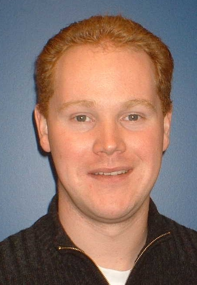Scanning Probe Optical Tweezers:
A new tool to study DNA protein interactions
Promotion date: 20 April 2006
| People in our group build and use equipment to look at single molecules at the smallest possible scale. |
What was your thesis about?
People in our group build and use equipment to look at single molecules at the smallest possible scale. A possible technique for looking at single DNA molecules for instance, is fluorescence. Another possibility, not for visualization but to apply and measure forces within a molecule, are optical tweezers With optical tweezers you capture a micron-sized transparent bead using strongly focused light. This bead is trapped in the focal point. To displace this bead a force has to be exerted on the bead. This force can be measured by determining the bead displacement since the optical trap behaves as a linear spring. With a bead in the optical trap and a second bead immobilized on a micro-pipette we catch a single DNA molecule and stretch it to measure its mechanical properties. DNA has a diameter of only 2 nanometer. The total length of DNA in the cell is in the order of 2 meters when stretched over its complete length. Normally the DNA string lies curled up in the cell, which is about 10 micrometer in diameter. To fit the DNA string into the cell, there are specific proteins like reels winding the DNA string. There are several of those and they form clusters. In our optical tweezers experiments we look at 16 micrometer of the DNA string and besides studying its mechanical properties we want to know where DNA-binding proteins are located on the molecule. To do so we use a probe that scans along the molecule and feel where these proteins are. In this way we can measure forces involved in the DNA-protein interactions and simultaneously locate the proteins on the molecule.
How do you do it?
We use the DNA of a virus that attacks a certain bacteria since it is which is fairly easy to extract its DNA. Both ends of the DNA are fixed to a bead in a biochemical way using two small molecules that form a strong bond. The fixation of DNA molecule is done in a flow chamber where one of the beads is held in the optical trap. Flowing in DNA molecules we can see if a molecule is connected to the bead once there is a sudden increase in force applied on the bead because the trapped bead has to drag along an additional molecule. After the connection of one end of a DNA molecule to the trapped bead we start ‘fishing’ with the second bead held by the micro-pipette.
But what was your specific research area?
To combine optical tweezers with a scanning probe technique. Let me explain more about the DNA. If you for instance catch a lot of sun, your DNA may be damaged at certain locations. You develop skin cancer. The DNA needs to be repaired to effect a cure. This cure requires a protein, that attaches itself to the DNA and finds the damaged spot.
With optical tweezers you can only measure the force within the DNA molecule, but you see nothing, you don’t know anything about the whereabouts of the damaged location. If we want to research that, we need to know more. I worked on developing a technique to also localize the proteins on the DNA. The initial idea was to combine optical tweezers with AFM (Atomic Force Microscopy), where the latter is a high resolution imaging tool. But in the final design we use a multi-walled carbon nanotube as a probe that is scanning along the DNA molecule with the proteins while we measure simultaneously the forces with the optical tweezers. Upon passing a protein with the probe a small additional force is generated in the DNA molecule and in that way we know where the protein is located. Basicly you can see this as moving with a knife along a thin wire.
Did you succeed?
Not with the proteins, but we were successful in the first step in the development of this new microscope.We attached beads of 400 nanometer to the DNA string and were able to localize those. That gave a lot of insight in how to go about it if you want to see even smaller structures. Furthermore we were able to localize particular molecules similar in size as proteins (1-10 nanometer), but for which we knew that they strongly interacts with certain other molecules that we fixed to the scanning probe.
Is it already possible to repair DNA?
O yes, it has been done and it is just an example to give in impression of why it is important to study DNA-protein interactions. Studying DNA-protein interactions with such a technique at such a small scale is still a fundamental research, but fascinating.
What did you like best about your research?
The challenge to combine the optical tweezers with a scanning probe technique into a completely new tool where beforehand it is unknown if you will succeed. It has never been done before. It was all a big and challenging experiment.
What was difficult
The many steps you need to take before you can do one single measurement.
Are you going to continue, will you be the first to detect the location of proteins on the DNA?
Yes, it has taken up such a lot of time to actually build the configuration that there was only a little time left to do the actual measurements. I will stay on until December and try to localize the proteins. I would be sorry to drop this research now, because if my technique turns out to be successful, publications in journals like Nature and Science are within reach.
And after December?
I would like to continue in research, but perhaps a different environment. I would like to go to a R&D department in industry.

